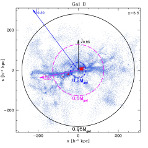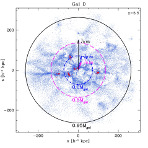|
|  |
Galaxies exhibit a spectacular variety of morphologies, from spheroids
to disks to bars, with tidal tails, and a zoo of peculiar objects of
irregular shapes. Until recently, astrophysicists thought that the
major morphological features of a galaxy are determined by the
assembly history and net spin of its surrounding dark matter halo:
mergers would create early type elliptical galaxies; whereas disks
would form within quiescently built halos whose angular momentum
content exceeds the average of the whole population. However, due to
the large computational costs of numerical simulations, it was the
studies of few individual systems that led to most of the progress in
our understanding of morphologies.
Thanks to the combined efforts of several research teams within Europe
collaborating as part of the "Virgo Consortium", we have been able
to study, for the very first time, the morphology and evolution of a
large sample of simulated galaxies that form within the standard
cosmological scenario. We focused our attention on objects like our
own Galaxy, the Milky Way, and explored the build-up of 100 objects
unbiasedly selected from wide, representative volumes of the
universe. For that, we use the ``Galaxies-Intergalactic Medium
Interaction Calculation'' simulations, which follow the evolution of
the dark matter, gas and stars that form within large cosmological
volumes throughout cosmic time.
As shown by Fig. 1, our simulated galaxies exhibit a wide variety of
morphologies, from dispersion-dominated spheroids (top) to pure disk
galaxies (bottom). Numerical simulations are a powerful tool because
they allow us to track the temporal evolution of each object, gaining
fundamental insight about the physical mechanisms that shape a
galaxy. For example, Fig.2 shows different stages of the build-up of
one of our simulated objects. Different snapshots show the
distribution of gas (red) and stars (yellow) that will collapse to
form a realistic looking disk-dominated galaxy at the present time.
We quantify morphologies by using a dynamical indicator, which
measures the fraction of the kinetic energy of the stars that is in
ordered rotation around a well-defined axis. That fraction is large
for disk-dominated galaxies where most stars move in the same plane
and close to circular orbits. On the other hand, it is almost null for
spheroid-like objects, where the dynamics is dominated by dispersion
instead of rotation.
This classification scheme allows us to study systematically the
correlations between morphology and properties of the dark matter
halos that these galaxies inhabit. Contrary to what is commonly
believed, we find that the merger activity and the angular momentum of
the dark matter halos relate poorly to the morphology of their central
galaxies. However, an interesting hint comes from another correlation:
disks preferentially form in objects where the contribution of gas
that has cooled from the ``hot corona'' is large, whereas spheroids
dominate for stars born from cold flows that deliver the material
directly to the central parts of the halo.
The angular momentum properties of the material accreted hot or cold
should differ: gas in the hot corona is forced to first homogenize its
spin before being aggregated to the central galaxy, whereas cold gas
flows unstopped to the centres, bringing along their intrinsic spin
without any mixing. Therefore, we look for further clues to galaxy
morphologies that might be hidden in the primordial angular momentum
distribution of each of our objects. Since the spin of the material
destined to form a galaxy is imprinted as soon as the object decouples
from the expansion of the Universe (around 10 billion years ago) and
remains approximately constant after that, we study the angular
momentum distributions of our galaxies at very early times, even
before each galaxy has formed.
Surprisingly, in this exercise spheroid- and disk-dominated galaxies
showed very different behaviours. Whereas for objects that evolved
into spheroids the different parts of the system showed clear
misalignments in their angular momentum (left panel Fig. 3), the spins
of different collapsing shells in disk-dominated galaxies were
remarkably well aligned (right panel Fig. 3). These results are
general to our whole sample and not a peculiarity of these two
galaxies.
In the scenario we propose, it is not only the net angular momentum
content which matters for galaxy morphology, but also the way in which
it is distributed across the proto-galaxy. Since gas further out takes
longer to accrete, material assembled later will be misaligned with
the rest. Stars formed from this gas will tend to destabilize any
existing disk and cancel out the net angular momentum of the system,
leaving in place a slowly-rotating stellar spheroid. This is a novel
mechanism for the formation of spheroids that does not rely on
merging. On the other hand, disk-dominated objects show coherence in
the angular momentum at turnaround, which allows newly accreted
material to settle into a stable disk where star formation can proceed
gradually and smoothly.
These considerations suggest that the final morphology of a galaxy is
imprinted early on for each object; even before the galaxy is born.
Laura V. Sales, Julio F. Navarro, Tom Theuns, Joop Schaye,
Simon D. M. White, Carlos S. Frenk, Robert A. Crain
and Claudio Dalla Vecchia
Publications
Crain, R.~A., Theuns, T., Dalla Vecchia, C., et al,
“Galaxies–intergalactic medium interaction calculation – I. Galaxy
formation as a function of large-scale environment”,
2009, MNRAS, 399, 1773
Sales, L.~V., Navarro, J.~F., Theuns, T., J. Schaye, S. White, et al,
“The Origin of Disks and Spheroids in Simulated Galaxies”,
2011,
 arXiv:1112.2220 arXiv:1112.2220
|



